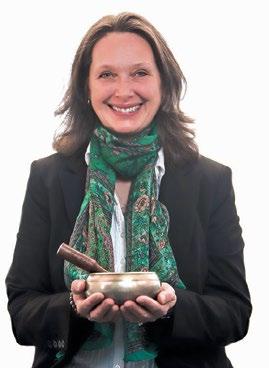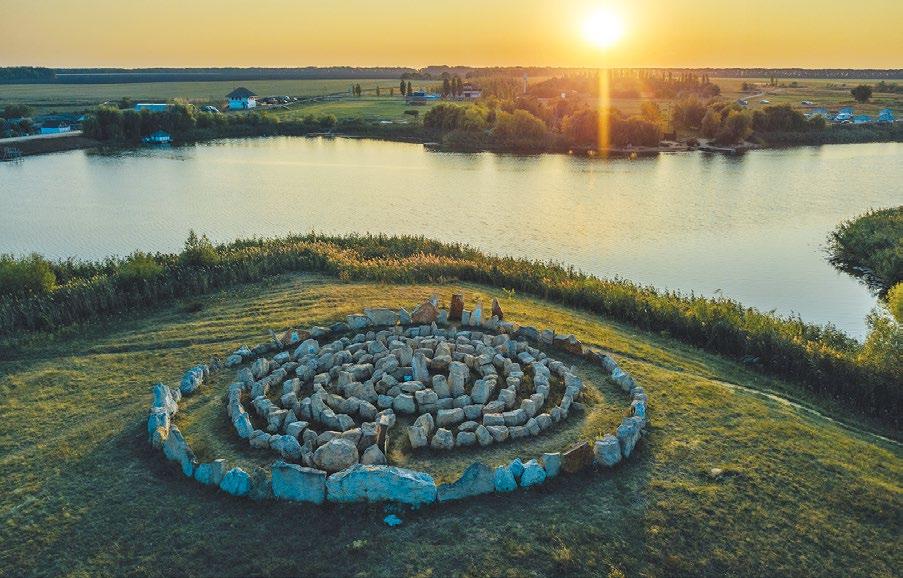
13 minute read
by Susan Meeker-Lowry
Dowsing for the Spirit of Place

Sig Lonegren, M.A. is a dowser living in Glastonbury, England. Before moving “across the big pond” he lived in Vermont, where he served as Selectman for Greensboro in Vermont's Northeast Kingdom, trustee of the American Society of Dowsers (ASD), and former head of their dowsing school. He also founded the ASD's first Earth Mysteries Group. He is the founder of The School of Mid-Atlantic Geomancy which offers an intensive, eight-month certification program in Modern European Geomancy, and the author of several books, including The Pendulum Kit, Spiritual Dowsing, and Labyrinths: Ancient Myths & Modern Uses. He is a trustee of The Chalice Well in Glastonbury and a council member of the British Society of Dowsers. [Sig currently resides in the Netherlands and can be reached at sig@ geomancy.org. — Ed.]
Sig was first exposed to dowsing by his mother forty years ago when she taught him to dowse with wire coat hangers using his home's underground water pipe as a target. But it wasn't until the summer solstice of 1970 that he realized dowsing was his life work. His mother had taken him to see the sunrise over a standing stone in central Vermont. The previous evening Sig had listened to master dowser Terry Ross and archeo-astronomer Byron Dix talking about energy leys, megalithic astronomy, and the like, all of which were new concepts. The next morning, instead of watching the sunrise with everyone else, Sig found himself repeatedly drawn to an earth-covered stone chamber on the site. He gave in to the compulsion and sat against the back wall, looking out the door.
Sig recounts: “Suddenly there were twenty-two other people inside the chamber with me. They had just simply materialized. They had white skin and some had beards. They wore white toga-like garments, and were sitting cross-legged on the floor in a regular pattern.” To Sig's astonishment, he found he was sharing the same space with one of the men. “I was he. I felt literally at one with these beings.” Just as he was thinking how cool the vision was, it vanished. But it left him with the deep knowing that those chambers, and ultimately geomancy, were to be his path.
I spoke with Sig in April at his home on Bove Town Road in Glastonbury. His house is aptly named “Sunny Bank.” It is painted bright, sunny yellow and has a fantastic hillside garden in its small, walled backyard complete with a replica of The Chalice Well's fountain. Although it was early spring, the garden was graced with flowers and vines already in bloom. Bove Town (so named because it is a“bove” town) is narrow and steep. From the back garden you can see the town of Glastonbury nestled at the base of the Tor.
SUSAN MEEKER-LOWRY: What is the dowsing state like? Is it like meditation?
SIG LONEGREN: Dowsing's brain wave activity resembles that of yogis, and I am heretical enough to argue that dowsing brings the things that meditation brings to you, only more quickly. Dowsing causes you to get to that brain wave point very quickly, while meditation is a slower introduction into that space. I think dowsing is meditation.
SUSAN MEEKER-LOWRY: But you're starting in a different place?
SIG LONEGREN: With dowsing you always start with your left brain. You always start with the “right question,” which is a left brain function. There are four different kinds of brain activity: beta, which is ordinary consciousness; alpha, which is a light trance state; theta, the dream state and when rapid eye movement occurs; and delta, which is deep, deep sleep. That's basically how it divides out. When you're dowsing, what's happening is the left hemisphere is functioning in beta asking the right questions, which is absolutely critical. Meanwhile there's a flare-up down in delta looking for the answer in the deep unconscious. It's a pattern that you can see both in dowsers and in yogis.
It's what I call “gnowing” [pronounced with a hard "g," as in gum.] Gnowing is honoring and using both hemispheres of the brain equally so that you do your rational best and your intuitive best. I believe this is the way forward. The thing about dowsing is that every time you want to ask a question on the other side, you have to come back here [points to left brain] to ask it. It makes you work the path.

INTERVIEW WITH SIG LONEGREN by Susan Meeker-Lowry Ready to wake up to the beauty of your life?

Living deliberately and unburdening your soul is within your reach.
You may just need a spiritual adventure guide to help you find your way.
Lisa Campbell
CERTIFIED MEDITATION & MINDFULNESS TEACHER
Improving your life by balancing the energies of your home.
MonShui
PAMELA SMITH
Feng Shui Consulting & Space Cleansing
MonShui.com | 617.947.3879 | Pam@MonShui.com

Dowsing Continued from page 35 Dowsing is a tool that can help you go very safely over to the other side and back.
SUSAN MEEKER-LOWRY: Can you talk a bit about asking the right question?
SIG LONEGREN: Well, Susan's asked me to come to her house to locate water for a well. Where's the nearest water? Oh, it's right over here, fifteen feet from the house. But it's nine hundred feet down, it goes dry from June to October every year, and it tastes like sulfur. I asked where's the nearest water and that's what I got. It wasn't the right question. Let's try again. We're using a backhoe with arms that only go nineteen feet or so down. So, we're looking for water that's less than nineteen feet down. We're a typical American household, so we need five gallons a minute. We want good, potable water and we want it to run year round. Now we've got the right question: Where's the nearest water that's less than twenty feet down, runs year round at over five gallons a minute, and is good, potable water? There's a very literal aspect to the unconscious.
SUSAN MEEKER-LOWRY: What is the difference between dowsing and geomancy?
SIG LONEGREN: Dowsing is best known as a tool for locating underground veins of water, oil, lost objects, missing persons, etc. It is also a tool for spiritual growth and intuition. Geomancy comes from “geo” — Gaia, Earth, — and “mancy” —divination of. Geomancy: divination of Earth. As with astrology, which works with power points in time, geomancy works with power points of place. The purpose of a geomancer is to work for harmony on Earth, fertility of Earth, and to create spaces that enhance the possibility that whatever you're trying to do there happens. Geomancers are, in essence, what I would call spiritual ecologists.
SUSAN MEEKER-LOWRY: The energy you work with is already there or not?
SIG LONEGREN: I've been involved in geomancy for thirty-five years. For the first thirty of those I would have said the energy was there first. I'm not so sure anymore. What we're finding in the latest work with labyrinths, which are single-pathed magical tools, is that if you put it in the best place you can find, given the limitations of the site — a backyard for instance — water will come to it.
There are two kinds of underground water: “water table” water that hydrologists are interested in, and primary, or juvenile, water. Primary water doesn't come from rainwater. It is created down in our Mom's belly as a by-product of various chemical reactions. Then it is forced under great pressure towards the surface of Earth, but most of the time it never gets there. Instead, it comes up through a neck, which dowsers in the U.S. call a “dome,” or a “blind spring” in Britain.
When it reaches an impermeable layer of rock or clay, the water goes out as veins at different depths. From above, this dome might look like a spider with an odd number of legs coming out of it. You find these dome features in sacred space, and it is this water that is drawn to labyrinths.
Occasionally a vein of primary water does reach the surface. These places are considered sacred and are places of healing and contemplation. The water from the Chalice Well, here in Glastonbury, for instance, is primary water. The Well has been considered a sacred place by ancient people and Christians alike. It has never run dry, even in droughts, and the temperature and flow are constant year round. Chalice Well water is chalybeate in nature — rich in iron — which is why it was called the Blood Spring in ancient times. This is the result of the chemical process that created the water.
SUSAN MEEKER-LOWRY: You were saying that it appears people have the ability to draw primary water to a place. I've seen ley line maps of Glastonbury that are amazing. There are so many lines coming directly into the area and leading to the Tor. Do you think ancient people had a role in that or do you think they were picking up on what was already there?
SIG LONEGREN: First some terminology. A “ley” is an alignment of sacred sites and is the result of our ancestors locating their holy sites over primary water, which is yin energy. Many, but not all, of these leys have energy leys flowing along them. Energy leys are straight beams of yang energy six to eight feet wide and, like a river, they have a direction of flow. A “power center” is a place where domes and veins of primary water and energy leys come together. They are where the yin and the yang, the female and male intersect. Sacred sites are not “hot,” or at their peak performance all the time. It's a cyclical thing and this is where astrology and geomancy come together. For instance, Stonehenge is hottest on the summer solstice sunrise.
Now to answer your question. I would go with John Michell's theory, which is discussed in his book Earth Spirit. When we were hunter/gatherers following the animals from the valleys up into the mountains on a seasonal cycle, we were naturally at power places when they were at their hottest point. It wasn't something we had to think about. You could say Gaia led us to the right places at the right times. Then when we became farmers and settled in the valleys, we needed to work with the energy centers where we were. We had to find ways to enhance Earth’s energies when they weren't at their peak.
I think that's when geomancy got going. There does seem to be a solid connection between farming and the first permanent temples built on sacred space. And there's certainly evidence that culture after culture built on the same places. So power places can be enhanced and even created over time when people consciously work with Earth’s energies. You don't just build a labyrinth, for instance; you have to walk it in a conscious manner. In fact, you don't have to physically construct it at all; just go out and walk the pattern, and after a time water will come. Creating the labyrinth brings the energy leys in, too.
SUSAN MEEKER-LOWRY: What attracts it?
SIG LONEGREN: Well, (pats the ground) we're working with a living being who's real open to communication.
SUSAN MEEKER-LOWRY: It's a very positive thing, when you think about it. You don't necessarily have to go to a sacred place that everyone recognizes as sacred. You can consciously create your own.
SIG LONEGREN: Yes. And that is my mission. To be the Johnny Appleseed of sacred spaces. And to encourage more and more people to build new ones.
SUSAN MEEKER-LOWRY: If I wanted to create sacred space, build a labyrinth for example, how would I go about it? How would I know where the right place was?
SIG LONEGREN: There are many different elements that come into the construction of sacred space, but the basic three are Earth’s energies, the astronomical relevance (like Stonehenge and the summer solstice), and the geometry of what you're building. I would encourage people who are interested in this to get in touch with the American Society of Dowsers and take a dowsing course.
But the basic process goes like this: First ask yourself, “Why am I building this? Do I want a lawn ornament or a place to do healing or meditate more effectively?” After your purpose is clear, decide the shape. Different shapes seem to enhance different energies. Then you need to identify where you can't build. For instance, if you want a thirty-five foot labyrinth, which is pretty standard, and you want it on your lawn, there are only so many places it can go. Once you have identified the most appropriate place, it's time to dowse for the center. At this point I would find some way to communicate with the spirit of place. You might bring a gift, maybe something to tie on the branch of a nearby tree. Then take a moment to calm down and tell this spirit what you have in mind, and ask it to work with you to make this a place of meditation, healing, or whatever you have in mind.
Now, using a pendulum or an L-rod, stand somewhere on your lawn and ask, “What direction is the best place for me to put the center of this labyrinth?” It will show you a line. Then go somewhere else and ask the same question again and notice where the two lines cross. That's the center. It's called triangulation. Then go to that spot and ask, “Is this the spot?”
SUSAN MEEKER-LOWRY: It sounds to me that you're saying every place has the potential to be sacred space.
SIG LONEGREN: That's true, although the reality seems to be that some places are more sacred than others, but every place has the potential to become sacred.
There's another phenomenon I'd like to mention here. There are domes of water with no energy leys associated with them. These places have traditionally been considered negative and even harmful for humans. When dowsers in the U.S. started exploring them, they were called “noxious zones,” which when you think about it, is a putdown of Mom.
The reality is, these are places of yin or feminine energy. Many animals, such as cats and cloven-hoofed animals love them. Several years ago, I decided to explore these yin areas myself. I discovered that they are like psychic vacuum cleaners, places where Mom just sucks everything down. If you sleep over one of these places, she'll suck your life force so it's not a good place to sleep. On the other hand, if you've got crap in your life, these are really good places to get rid of it. Mom takes that crap and breaks it down and takes it away. These are wonderful places for a compost pile, by the way.
Think of it like this: The wheel of life is creation and growth as well as death and decomposition. There's no good or bad, just parts of the whole. I like to call these places Kali centers. They restore balance and help you get rid of crap that hinders your spiritual growth.
We need to connect with Mom, and become open to the spirit of the place we call home. But it’s simple arrogance to talk about saving Earth; it’s ourselves we’re saving. So many people don’t have a clue what nature is about. We have the job of waking people up, which happens one person at a time. Geomancy is a very subversive tool in that it wakes you up to what we’re talking about: Earth is alive.
Susan Meeker-Lowry is a frequent contributor to Spirit of Change. [Susan is currently the owner of GaiasGardenHerbals at etsy.com — Ed.]










